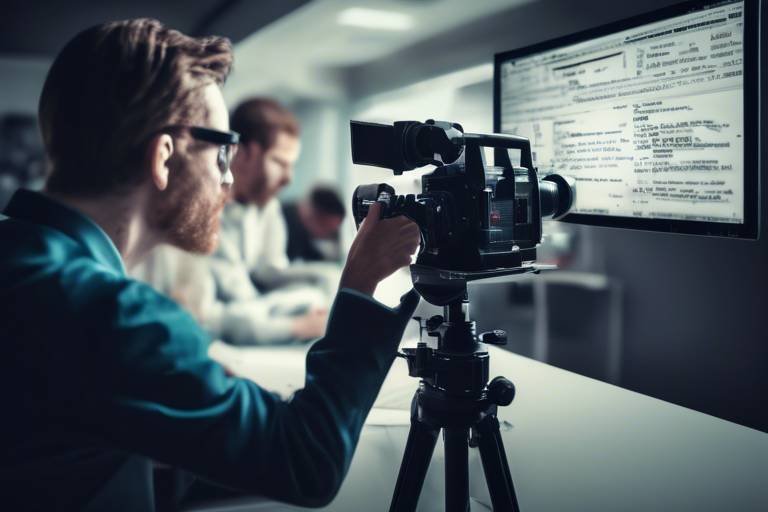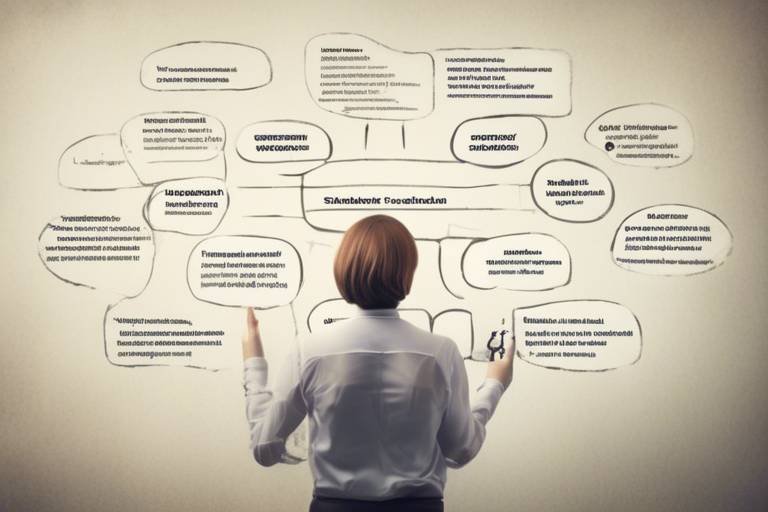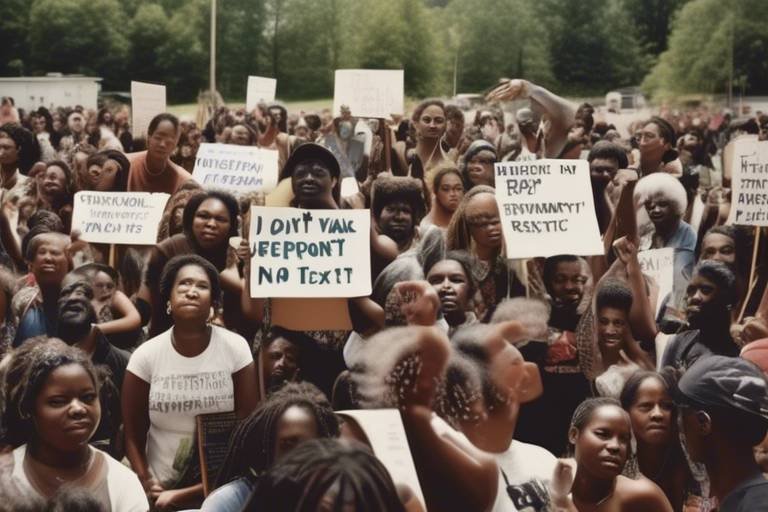How to Use Video Analysis in Observational Research
In today's fast-paced world, where data is king, video analysis has emerged as a game-changer in the field of observational research. Imagine being able to capture not just the actions of subjects but also the intricate nuances of their behaviors, interactions, and environments. Video analysis allows researchers to do just that, providing a rich tapestry of data that can be revisited and scrutinized from multiple angles. This article will guide you through the ins and outs of integrating video analysis into your research, highlighting its myriad benefits, methodologies, and applications across various fields.
One of the most compelling aspects of video analysis is its ability to enhance the accuracy of data collection. Traditional observational methods often rely on the researcher’s memory and notes, which can be prone to bias and error. In contrast, video recordings provide a permanent record that can be reviewed multiple times, ensuring that no detail is overlooked. This means researchers can focus on the bigger picture while knowing they have the ability to dive deeper into specifics whenever necessary.
Moreover, video analysis enriches the data collected by adding layers of context that are often missed in written notes. For example, consider a study on classroom interactions. A researcher might note that a student raised their hand, but video footage can reveal the tone of voice, facial expressions, and even the reactions of peers, all of which are vital for a comprehensive understanding of the interaction. This depth of insight is invaluable, especially in fields like education, psychology, and social sciences where human behavior is complex and multifaceted.
As we delve into the methodologies of video analysis, it’s essential to recognize that the choice of equipment plays a critical role. Selecting the right cameras and recording devices is not just about capturing footage; it's about ensuring that the data collected is of the highest quality. In the following sections, we will explore the various types of cameras available, their features, and how to set them up effectively for optimal data collection.
Video analysis offers numerous advantages in observational research, including improved accuracy, enhanced data richness, and the ability to revisit and analyze footage for deeper insights.
Selecting appropriate cameras and recording devices is crucial for effective video analysis. This section discusses various options and considerations for capturing high-quality footage in different research settings.
Different types of cameras, such as handheld, fixed, and action cameras, have unique features that can impact data collection. This subsection examines the pros and cons of each type for research purposes.
Understanding the importance of resolution and frame rate is vital for capturing clear and detailed video. This part discusses how these technical specifications affect the quality of observational data.
Incorporating audio into video analysis can provide context and enhance understanding. This section explores the importance of sound quality and recording techniques in observational research.
Proper setup is essential for effective video analysis. This subsection outlines key factors to consider, such as lighting, angles, and participant positioning, to optimize data collection.
Once video data is collected, analyzing it effectively is crucial. This section covers various analysis techniques, including coding, thematic analysis, and software options for processing video data.
Understanding the differences between qualitative and quantitative analysis methods is essential for interpreting video data. This part discusses when to use each approach based on research objectives.
Numerous software tools are available for video analysis, each offering unique features. This subsection reviews popular options and their applications in observational research.
- What is video analysis in observational research? Video analysis involves recording and reviewing video footage to gain insights into behaviors, interactions, and contexts that are difficult to capture through traditional observational methods.
- What are the main benefits of using video analysis? The primary benefits include enhanced accuracy, the richness of data, and the ability to revisit footage for deeper analysis.
- How do I choose the right equipment for video analysis? Consider factors such as camera type, resolution, frame rate, and audio quality when selecting equipment for your research.
- What software tools are recommended for video analysis? Popular software options include NVivo, MAXQDA, and Dedoose, each offering different features suitable for qualitative and quantitative analysis.

The Benefits of Video Analysis
Video analysis is revolutionizing the way we conduct observational research, and its benefits are truly remarkable. One of the most significant advantages is the improved accuracy it brings to data collection. By capturing real-time interactions and behaviors, researchers can minimize biases that often accompany traditional observational methods. Imagine trying to recall a complex social interaction from memory; it’s like trying to piece together a puzzle without all the pieces. With video, every detail is preserved, allowing for a more precise interpretation of the data.
Furthermore, video analysis enhances the richness of data collected during research. Unlike written notes or audio recordings, video captures the subtleties of human behavior—facial expressions, body language, and environmental context. This multi-dimensional data can lead to deeper insights and a more comprehensive understanding of the subject matter. For instance, in educational settings, observing how students interact in group work can reveal not just what they say, but how they communicate non-verbally, which is crucial for understanding group dynamics.
Another compelling benefit of video analysis is the ability to revisit and analyze footage multiple times. Researchers can review the same data from different angles or focus on specific moments that may have been overlooked during the initial observation. This iterative process allows for a more thorough analysis, akin to a director reviewing footage of a film to ensure every scene conveys the intended message. The opportunity to pause, rewind, and reflect enables researchers to extract nuanced insights that contribute to the overall findings.
Moreover, video analysis can be particularly beneficial in fields such as healthcare, education, and social sciences. For example, in healthcare, analyzing patient interactions with providers can help identify areas for improvement in communication and care practices. In educational research, examining classroom dynamics through video can inform teaching strategies and enhance learning experiences. The versatility of video analysis makes it a powerful tool across various disciplines, facilitating a deeper understanding of complex phenomena.
In summary, the benefits of video analysis in observational research are profound. From enhancing accuracy and richness in data to allowing for repeated analysis and application across diverse fields, video analysis stands out as a transformative approach. As researchers continue to embrace this technology, the potential for groundbreaking discoveries and insights remains limitless.
- What types of research can benefit from video analysis? Video analysis can be applied in various fields, including education, healthcare, social sciences, and marketing research.
- How does video analysis improve data accuracy? It captures real-time interactions and behaviors, reducing biases that can occur in traditional observational methods.
- Can video analysis be used for both qualitative and quantitative research? Yes, video analysis can support both qualitative and quantitative approaches, depending on the research objectives.
- What are some common software tools used for video analysis? Popular software options include NVivo, ATLAS.ti, and Dedoose, each offering unique features for processing and analyzing video data.

Choosing the Right Equipment
When it comes to conducting observational research, one of the most critical steps is . The tools you select can significantly impact the quality of your data and the insights you can derive from it. Imagine trying to capture the nuances of human behavior with a low-quality camera; it would be like trying to read a book through a foggy window. To ensure clarity and detail in your research, it's essential to invest in equipment that meets your specific needs.
First and foremost, consider the type of camera that will best suit your research environment. There are several options available, each with its own advantages and disadvantages. For instance, handheld cameras offer mobility and flexibility, making them ideal for dynamic settings where movement is frequent. On the other hand, fixed cameras can provide consistent angles and stability, perfect for capturing specific locations over time. Action cameras, known for their durability and compact size, are great for field studies where environmental conditions may be challenging.
Next, let's talk about resolution and frame rate. These technical specifications are crucial for ensuring that your video footage is both clear and detailed. Higher resolution means more pixels, which translates to sharper images. Frame rate, measured in frames per second (fps), impacts how smoothly motion is captured. For instance, a frame rate of 30 fps is generally sufficient for most observational studies, but if you're observing fast-paced activities, you might want to consider 60 fps or even higher. This way, you won't miss any critical moments that could provide valuable insights.
Another aspect to consider is audio quality. While video captures visual data, sound can add another layer of context that enhances understanding. Poor audio can obscure important dialogues or interactions, leading to misinterpretations. Therefore, investing in high-quality microphones is advisable, especially if your research involves discussions or environmental sounds that are integral to the context. Depending on your setup, you might choose between lavalier mics for individual subjects or shotgun mics for broader sound capture.
Lastly, don't overlook the importance of setting up your equipment correctly. Factors such as lighting, camera angles, and participant positioning can dramatically affect the quality of your footage. For instance, natural light can enhance video quality, but it also varies throughout the day. Ensure that your cameras are positioned to capture the action from the best angles, and always test your setup before the actual recording begins. Remember, a well-planned setup is the foundation of successful video analysis.
In summary, selecting the right equipment for observational research is not just about picking the latest gadgets. It's about understanding your research goals and choosing tools that will help you achieve them. With the right cameras, audio devices, and setup, you can collect rich, high-quality data that will enhance your analysis and interpretation.
- What type of camera is best for observational research? The best type of camera depends on your specific research needs. Handheld cameras are great for flexibility, while fixed cameras are ideal for stable, long-term observations.
- How important is audio in video analysis? Audio is crucial as it provides context and can clarify interactions that are visually captured in the video.
- What resolution should I aim for in my recordings? A resolution of at least 1080p is recommended for clear images, but higher resolutions may be necessary for detailed analysis.
- Is lighting important for video quality? Yes, lighting plays a significant role in video quality. Natural light is ideal, but you should always test your setup to ensure proper exposure.

Camera Types and Features
When it comes to video analysis in observational research, the choice of camera can significantly influence the quality and effectiveness of your data collection. There are several types of cameras available, each with its own set of features that cater to different research needs. Understanding these options can help you make an informed decision. Let's dive into the main types of cameras commonly used in research settings: handheld cameras, fixed cameras, and action cameras.
Handheld Cameras are versatile and can be easily maneuvered to capture footage from various angles. They are ideal for dynamic environments where subjects are in motion. However, the challenge with handheld cameras is maintaining stability, which can affect video quality. Many modern handheld cameras come equipped with image stabilization features, which can mitigate this issue. Additionally, they often have adjustable zoom and focus, allowing researchers to hone in on specific details.
Fixed Cameras, on the other hand, are set up in a stationary position, capturing a wide view of the environment. These are particularly useful in settings where subjects interact in a defined space, such as classrooms or meeting rooms. The advantage of fixed cameras is that they can be left unattended, allowing researchers to focus on other aspects of their study. However, the limitation is that they cannot easily follow subjects if they move out of frame. It's essential to carefully consider the placement of fixed cameras to ensure they capture the relevant action.
Action Cameras are compact and designed for high-impact environments. They are perfect for capturing fast-paced activities, such as sports or field studies. With their rugged design and wide-angle lenses, action cameras can provide unique perspectives that other types may miss. However, their small size often means they have limited battery life and storage capacity, which can be a drawback for extended observations. Researchers need to plan accordingly to ensure they capture all necessary footage.
To summarize, here’s a quick comparison of the camera types:
| Camera Type | Advantages | Disadvantages |
|---|---|---|
| Handheld Cameras | Versatile, adjustable zoom, portable | Stability issues, potential for shaky footage |
| Fixed Cameras | Unattended operation, wide view | Limited movement tracking, fixed perspective |
| Action Cameras | Compact, rugged, wide-angle | Limited battery life, small storage capacity |
Ultimately, the choice of camera should align with your research objectives and the environment in which you'll be working. Consider factors such as the nature of the subjects, the required mobility, and the specific features that will enhance your observational capabilities. Selecting the right camera is not just about the technical specifications; it's also about how well it fits into your overall research strategy.

Resolution and Frame Rate
When it comes to video analysis in observational research, understanding resolution and frame rate is absolutely crucial. Think of resolution as the clarity of a picture; it determines how much detail you can capture. Higher resolution means more pixels, which translates into a sharper image. For example, a video recorded in 4K resolution (3840x2160 pixels) will provide significantly more detail than one recorded in standard definition (720x480 pixels). This is particularly important in observational studies where minute details can make a huge difference in data interpretation.
Frame rate, on the other hand, refers to the number of frames captured per second (fps). A video at 30 fps will appear smoother than one at 15 fps. This smoothness is essential when analyzing fast-paced actions or interactions, as it helps in capturing the nuances of behavior that might otherwise be missed. For example, if you're studying the interactions of children in a playground, a higher frame rate will allow you to see the subtleties of their movements and interactions more clearly.
To give you a better idea of how resolution and frame rate work together in video analysis, consider the following table:
| Resolution | Common Use Cases | Recommended Frame Rate |
|---|---|---|
| 480p (SD) | Basic video documentation | 15-30 fps |
| 720p (HD) | Online video content, interviews | 30 fps |
| 1080p (Full HD) | Documentaries, detailed observational studies | 30-60 fps |
| 4K (Ultra HD) | High-detail research, professional filmmaking | 60 fps or higher |
In summary, both resolution and frame rate play pivotal roles in ensuring that your video data is as rich and informative as possible. Choosing the right combination based on your research objectives can dramatically improve the quality of your findings. Whether you're capturing the subtle gestures of participants or the fast-paced actions of a sporting event, paying attention to these technical specifications will enhance your observational research.
- What is the ideal resolution for observational research? It depends on your study's needs, but generally, 1080p or higher is recommended for detailed analysis.
- How does frame rate affect video analysis? A higher frame rate captures smoother motion, making it easier to analyze fast actions or interactions.
- Can I improve video quality in post-production? While some enhancements can be made, capturing high-quality footage initially is crucial for the best results.

Audio Considerations
When it comes to video analysis in observational research, audio quality is often an overlooked component, yet it plays a pivotal role in enriching the data collected. Imagine watching a captivating video only to find that the dialogue is muffled or the background noise is overpowering. This can lead to misunderstandings and misinterpretations of the data. Therefore, ensuring high-quality audio recording should be a top priority for researchers.
One of the key aspects to consider is the environment in which you are recording. Different settings can introduce various sound challenges. For instance, if you’re filming in a bustling café, you might encounter a cacophony of clinking dishes, chatter, and music that could drown out the primary sounds you wish to capture. Conversely, a quiet room can provide a clearer soundscape, but it may also introduce echoes that could distort the audio. Therefore, selecting the right location is crucial.
Moreover, the choice of microphone can significantly impact audio clarity. There are several types of microphones available, each suited for different recording scenarios:
- Lavalier Microphones: These are small, clip-on mics that are perfect for interviews or situations where the speaker needs to move freely.
- Shotgun Microphones: Designed to capture sound from a specific direction, these are ideal for outdoor filming or when you want to minimize background noise.
- Handheld Microphones: Often used in interviews, they allow for flexibility but may pick up more ambient noise.
In addition to microphone selection, it’s essential to consider recording techniques. Ensure that the microphone is positioned appropriately to capture clear audio without interference. For instance, if you're recording a group discussion, placing a microphone centrally can help in picking up all voices equally. Furthermore, using windshields on microphones during outdoor shoots can mitigate wind noise, leading to cleaner audio.
Lastly, post-production techniques can also enhance audio quality. Utilizing software to edit and refine sound can help eliminate unwanted noise, balance audio levels, and even add sound effects that enrich the viewing experience. Remember, a well-executed video analysis doesn’t just rely on visuals; it’s a symphony of sight and sound that, when harmonized, can lead to profound insights.
- What audio equipment is best for video analysis? The best audio equipment depends on your specific needs, but lavalier and shotgun microphones are often recommended for their clarity and versatility.
- How can I improve audio quality in a noisy environment? Consider using directional microphones and soundproofing techniques, such as recording in quieter spaces or using sound barriers.
- Is it necessary to edit audio in post-production? While not always necessary, editing can significantly enhance audio quality by removing background noise and balancing sound levels.

Setting Up for Success
When it comes to video analysis in observational research, the setup is everything. Imagine trying to capture the perfect moment in a bustling café, only to realize your camera is positioned at an awkward angle, missing the action entirely. To avoid such pitfalls, it’s crucial to consider several key factors that can significantly enhance the quality of your data collection. First and foremost, lighting plays a pivotal role. Natural light can be your best friend, but if you’re in a dimly lit environment, you may need to invest in some artificial lighting to ensure your footage is bright and clear. Think of lighting as the seasoning in a recipe; too little can leave your dish bland, while the right amount can elevate it to gourmet status.
Next, let’s talk about angles. The angle at which you position your camera can dramatically change the narrative of your footage. A wide shot might capture a group’s dynamics, while a close-up can reveal individual expressions and reactions. It’s like telling a story; sometimes, you want the big picture, and other times, you need to zoom in on the details. Experimenting with different angles during your setup can provide a richer context for your analysis.
Another critical aspect to consider is participant positioning. The way participants are arranged in the frame can either enhance or detract from the data you’re collecting. For instance, if you’re studying group interactions, ensure that all participants are visible and that their body language can be easily interpreted. It’s akin to arranging a stage for a play; every actor needs to be in the right spot for the audience to grasp the full story. Also, think about the distance between the camera and the subjects; too far away, and you risk losing important details, too close, and you might invade their personal space.
Finally, don’t forget about background noise. In observational research, the context is just as important as the actions being recorded. If your video captures a lively discussion, but the audio is filled with distracting sounds, you may miss out on critical insights. Using directional microphones can help focus on the subjects while minimizing background noise. It’s like tuning a radio; you want to hone in on the right frequency to get the clearest sound.
In summary, setting up for success in video analysis is about creating an environment that fosters clear and insightful data collection. By paying attention to lighting, angles, participant positioning, and audio quality, you can significantly enhance the richness of your observational research. Remember, a well-set stage leads to a captivating performance!
- What type of camera is best for video analysis?
The best camera depends on your specific needs, but generally, a camera with good resolution and frame rate is ideal. Consider factors like portability and ease of use. - How can I ensure high-quality audio in my videos?
Use external microphones and test your audio setup before recording. Minimizing background noise is crucial for clear sound. - What software is recommended for video analysis?
Popular software options include NVivo, Atlas.ti, and Dedoose, each offering unique features for analyzing video data. - Can I use video analysis for quantitative research?
Yes, video analysis can be utilized for both qualitative and quantitative research, depending on your research objectives.

Data Analysis Techniques
Once you've captured your video data, the next big question is: how do you make sense of it all? Analyzing video footage can feel like trying to find a needle in a haystack, but with the right techniques, you can uncover valuable insights that might otherwise go unnoticed. Video analysis isn't just about watching the footage; it's about diving deep into the content, understanding the nuances, and extracting meaningful patterns. In this section, we'll explore various data analysis techniques that can elevate your observational research to new heights.
One of the most effective methods for analyzing video data is coding. This involves breaking down the footage into manageable segments and assigning labels or codes to specific behaviors or events. Think of it as creating a roadmap through your video, allowing you to easily navigate back to key moments. For instance, if you're studying classroom interactions, you might code instances of student engagement, teacher feedback, or group discussions. This systematic approach not only helps in organizing your findings but also makes it easier to quantify behaviors for later analysis.
Another powerful technique is thematic analysis. This method focuses on identifying patterns or themes within the video data, enabling researchers to capture the essence of the observed phenomena. Imagine watching a film and noticing recurring motifs; thematic analysis works similarly. It's about looking for overarching narratives or trends that emerge from the footage. By synthesizing these themes, you can gain a deeper understanding of the context and implications of your research. For example, if your video captures a community meeting, you might identify themes related to participation, decision-making, or conflict resolution.
In today's digital age, leveraging software tools can significantly enhance your video analysis process. There are numerous programs available that can assist in coding, annotating, and analyzing video data. Some popular options include:
| Software | Features | Best For |
|---|---|---|
| NVivo | Qualitative data analysis, coding, and visualization | Social sciences research |
| MAXQDA | Mixed methods analysis, visual tools | Comprehensive research projects |
| Observer XT | Behavioral analysis, real-time coding | Animal behavior studies |
These tools not only streamline the analysis process but also provide features that facilitate collaboration among research teams. Imagine being able to share your findings in real-time and work together to interpret the data! However, it’s essential to choose the right software based on your specific research needs and objectives.
When it comes to analyzing video data, understanding the difference between qualitative and quantitative analysis is crucial. Qualitative analysis focuses on the richness of the data, emphasizing context, meaning, and subjective experiences. On the other hand, quantitative analysis is all about numbers, metrics, and statistical significance. Depending on your research goals, you might find that a mixed-methods approach—combining both qualitative and quantitative techniques—provides the most comprehensive insights. For example, you could quantify the frequency of certain behaviors while also exploring the underlying motivations through qualitative coding.
In summary, the techniques you choose for analyzing your video data can significantly impact the depth and quality of your findings. By employing coding, thematic analysis, and utilizing the right software tools, you can unlock a treasure trove of insights from your observational research. Remember, the goal is to not just watch the footage, but to engage with it, question it, and ultimately, learn from it.
- What is the best way to start video analysis?
Begin by clearly defining your research questions and objectives. This will guide your coding and analysis process. - How can I ensure the accuracy of my video analysis?
Use multiple coders to analyze the same footage and compare results to enhance reliability and validity. - Are there specific ethical considerations for video analysis?
Yes, always obtain consent from participants and ensure their privacy is respected during the analysis process.

Qualitative vs. Quantitative Analysis
When diving into the world of video analysis in observational research, it's essential to understand the distinction between qualitative and quantitative analysis. These two approaches serve different purposes and can yield vastly different insights from the same footage. Imagine you're a detective trying to solve a mystery; qualitative analysis is like gathering personal testimonies and narratives from witnesses, while quantitative analysis is akin to collecting hard evidence, statistics, and measurable data. Both are crucial, but they answer different questions.
Qualitative analysis focuses on understanding the why and how behind behaviors and interactions. It digs deep into the context, emotions, and meanings that participants attach to their actions. This method is particularly useful in exploratory research where the goal is to uncover patterns, themes, or insights that aren’t immediately obvious. For instance, if you’re studying classroom interactions, qualitative analysis might reveal how students feel about group work or their perceptions of the teacher's approach.
On the other hand, quantitative analysis is all about measuring and quantifying behaviors. It answers questions like how many or how often something occurs. This approach is useful for establishing trends, making comparisons, and generating statistical evidence. For example, in the same classroom study, you might quantify the number of times students raise their hands or how often they engage in discussions. By applying statistical methods, you can determine if there’s a significant difference in participation between different teaching styles.
To illustrate the differences more clearly, consider the following table that summarizes the key distinctions between qualitative and quantitative analysis:
| Aspect | Qualitative Analysis | Quantitative Analysis |
|---|---|---|
| Focus | Understanding meanings and experiences | Measuring behaviors and outcomes |
| Data Type | Descriptive, textual, and visual data | Numerical and statistical data |
| Methods | Interviews, observations, thematic analysis | Surveys, experiments, statistical analysis |
| Outcome | Rich, detailed insights | Generalizable results and trends |
In practice, many researchers find that combining both qualitative and quantitative methods can provide a more comprehensive understanding of their subject matter. This mixed-methods approach allows you to explore the depth of qualitative insights while also providing the breadth of quantitative data. Imagine having the best of both worlds—like being able to see the intricate details of a painting while also stepping back to appreciate the entire canvas.
Ultimately, the choice between qualitative and quantitative analysis depends on your research questions, objectives, and the context of your study. So, whether you're looking to uncover the rich narratives behind human behavior or to quantify patterns and trends, understanding these two approaches will arm you with the necessary tools to conduct effective observational research.
- What is the main difference between qualitative and quantitative analysis?
Qualitative analysis seeks to understand meanings and experiences, while quantitative analysis focuses on measuring and quantifying behaviors. - Can I use both methods in my research?
Yes! Many researchers use a mixed-methods approach to gain a more comprehensive understanding of their subject matter. - When should I use qualitative analysis?
Use qualitative analysis when your research aims to explore underlying reasons, motivations, and patterns in behavior. - When is quantitative analysis more appropriate?
Quantitative analysis is ideal when you need to measure variables, evaluate trends, and establish statistical evidence.

Software Tools for Video Analysis
When it comes to video analysis in observational research, the right software tools can make all the difference. These tools not only help in processing and analyzing video footage but also enhance the overall research experience by providing intuitive interfaces and powerful functionalities. Imagine trying to find a needle in a haystack; without the right tools, that task becomes daunting. Similarly, video analysis software can sift through vast amounts of footage, allowing researchers to focus on what truly matters.
There are several software options available, each with its unique features tailored to different research needs. Some of the most popular tools include:
- NVivo: This is a qualitative data analysis software that allows researchers to code and analyze video data effectively. With NVivo, you can integrate video with other data types, such as interviews and surveys, providing a holistic view of your research.
- Observer XT: Designed specifically for behavioral research, Observer XT offers powerful coding and analysis features. It allows researchers to create detailed behavioral codes and analyze video data in real-time, making it an excellent choice for observational studies.
- ELAN: This tool is particularly useful for linguists and social scientists. ELAN supports the annotation of video and audio data, enabling researchers to highlight specific interactions or phenomena within the footage.
- Qualisys: For those in motion analysis, Qualisys provides advanced motion capture and analysis capabilities. This is particularly beneficial in sports science and biomechanics research.
Each of these tools has its strengths and weaknesses, so choosing the right one depends on your specific research goals. For instance, if you're focusing on qualitative analysis, NVivo might be your best bet, while Observer XT could be ideal for behavioral studies. It’s essential to weigh the pros and cons of each tool based on factors like ease of use, integration capabilities, and the specific features that align with your research objectives.
Moreover, most of these software solutions offer training resources and user support, which can be invaluable for researchers who are new to video analysis. Utilizing these resources can significantly reduce the learning curve and enhance the quality of your analysis. After all, the more comfortable you are with the tools at your disposal, the more insightful your findings will be.
In summary, the landscape of video analysis software is rich and varied, providing researchers with numerous options to enhance their observational studies. By choosing the right tool, you can transform raw video footage into meaningful data, uncovering insights that might otherwise remain hidden. So, take the time to explore these options and find the software that fits your research needs like a glove!
Q: What is video analysis in observational research?
A: Video analysis is the process of capturing and analyzing video footage to gather data on specific behaviors, interactions, or events in observational research. It allows researchers to review recorded material multiple times, enhancing data richness and accuracy.
Q: Do I need special equipment for video analysis?
A: While basic recording devices can suffice, investing in high-quality cameras and microphones can significantly improve the clarity and detail of your footage, leading to better analysis outcomes.
Q: Can I analyze video data without specialized software?
A: While it's possible to analyze video data without specialized software, using dedicated tools can streamline the process, making it easier to code, categorize, and draw insights from your footage.
Q: How do I choose the right software for video analysis?
A: Consider your specific research needs, such as the type of data you're analyzing, your budget, and the software's ease of use. It may also be helpful to read reviews or try out free trials before making a decision.
Frequently Asked Questions
- What are the main benefits of using video analysis in observational research?
Video analysis significantly enhances the accuracy and richness of data collected during observational research. It allows researchers to revisit footage, ensuring that no detail is overlooked. This method also aids in capturing non-verbal cues and interactions that might be missed in traditional note-taking.
- How do I choose the right equipment for video analysis?
Selecting the appropriate equipment is crucial for effective video analysis. Consider factors such as the research environment, the type of interactions being studied, and the level of detail required. Handheld cameras offer flexibility, while fixed cameras provide stability; choosing the right one can make all the difference in your data collection.
- What camera features should I look for when conducting video analysis?
When selecting a camera, pay attention to resolution and frame rate. Higher resolution ensures clearer images, while a suitable frame rate captures smooth motion. Additionally, consider audio quality, as incorporating sound can provide valuable context to the visual data.
- What are the key factors for setting up video analysis effectively?
Proper setup is essential for capturing high-quality video. Ensure adequate lighting, select appropriate angles, and position participants thoughtfully. A well-planned setup can drastically improve the quality of your observational data and lead to more insightful analysis.
- How do I analyze video data once it’s collected?
Analyzing video data involves various techniques, including coding and thematic analysis. Depending on your research objectives, you may choose qualitative methods to explore themes or quantitative methods to measure specific behaviors. Utilizing software tools can also streamline the analysis process and enhance your findings.
- What software tools are recommended for video analysis?
There are several software tools available for video analysis, each with unique features tailored for different research needs. Popular options include Ethnograph, NVivo, and Observer XT, which offer functionalities like coding, tagging, and detailed reporting to help researchers interpret their data effectively.
- When should I use qualitative vs. quantitative analysis methods?
Choosing between qualitative and quantitative analysis depends on your research goals. Qualitative methods are ideal for exploring complex behaviors and interactions, while quantitative methods are better suited for measuring specific variables or patterns. Understanding your objectives will guide you in selecting the appropriate approach.



















